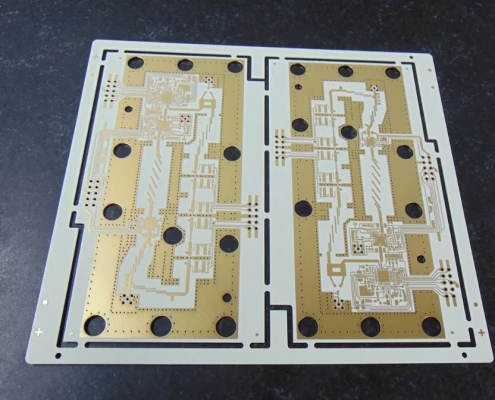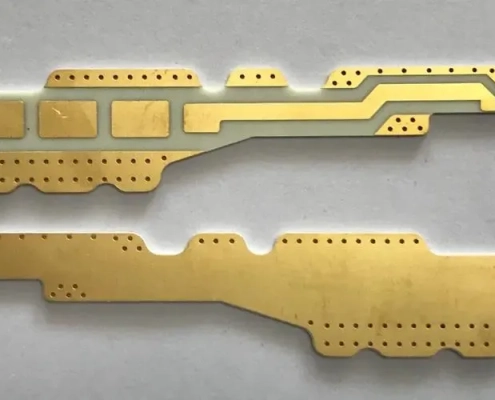Rogers 4350B: Applications in Communication Systems
Rogers 4350B stands out as a premier high-performance laminate material at the forefront of the electronics industry. Renowned for its exceptional electrical properties and reliability, it serves as a cornerstone in the construction of high-frequency circuits and RF applications. With its superior dielectric constant, low loss tangent, and excellent thermal stability, Rogers 4350B enables engineers to achieve optimal signal integrity and performance in demanding electronic designs. Its widespread adoption across various sectors, including telecommunications, aerospace, and automotive, underscores its versatility and importance in modern technology. As a trusted choice for critical electronic components, Rogers 4350B continues to drive innovation and shape the landscape of advanced electronic systems.
Key Features of Rogers 4350B
Rogers 4350B boasts a plethora of key characteristics that make it a preferred choice for high-frequency circuit design and performance optimization:
Dielectric Constant
- Rogers 4350B exhibits a stable dielectric constant (εr) of approximately 3.48 at room temperature, ensuring consistent signal propagation and minimal signal distortion.
- The low dielectric constant of Rogers 4350B enables the miniaturization of circuits and enhances impedance matching capabilities, critical for high-frequency applications.
Loss Factor (Dissipation Factor)
- With a low loss tangent (tan δ) of around 0.0037 at 10 GHz, Rogers 4350B minimizes signal loss and attenuation, preserving signal integrity over long transmission distances.
- Its low dissipation factor ensures efficient energy transfer and reduces the risk of signal degradation, vital for high-speed data transmission and RF systems.
Temperature Stability
- Rogers 4350B exhibits exceptional temperature stability across a wide operating range, maintaining its electrical properties under varying environmental conditions.
- Its coefficient of thermal expansion (CTE) is carefully engineered to match that of copper, preventing delamination and ensuring mechanical reliability in harsh operating environments.
Impact on High-Frequency Circuit Design and Performance
- The consistent dielectric constant of Rogers 4350B facilitates precise impedance control, enabling engineers to achieve optimal matching and minimize signal reflections in high-frequency circuits.
- Its low loss tangent translates to reduced insertion loss and improved signal-to-noise ratio, critical for maintaining signal integrity in high-speed digital and RF applications.
- The temperature stability of Rogers 4350B ensures reliable performance across a broad range of operating conditions, making it suitable for demanding aerospace, telecommunications, and automotive applications.
Overall, the exceptional electrical properties of Rogers 4350B empower engineers to design high-performance, reliable, and compact electronic systems capable of operating at high frequencies with minimal signal degradation.
Comparison with Other Materials
Applications of Rogers 4350B
Temperature Characteristics and Stability
Conclusion
Rogers 4350B stands as a cornerstone in high-frequency circuit design, offering unparalleled electrical performance, temperature stability, and reliability. Its importance and advantages in electronic applications are evident from its widespread adoption across various industries. Here’s a detailed look at its significance and future prospects:
Importance and Advantages of Rogers 4350B
- Irreplaceable Role: Rogers 4350B plays an irreplaceable role in high-frequency circuit design, providing engineers with a reliable substrate material capable of delivering consistent electrical performance and signal integrity.
- Enhanced Electrical Performance: Its low dielectric constant, minimal loss tangent, and stable properties ensure efficient signal transmission, impedance matching, and minimal signal distortion, crucial for high-speed digital and RF applications.
- Temperature Stability: Rogers 4350B’s exceptional temperature stability enables reliable operation across a wide range of environmental conditions, from extreme cold to high heat, making it suitable for diverse applications in aerospace, telecommunications, automotive, and beyond.
Future Trends and Potential Application Areas
- 5G and Beyond: With the ongoing rollout of 5G networks and the emergence of future wireless communication standards, Rogers 4350B is poised to play a pivotal role in supporting higher data rates, lower latency, and increased network capacity.
- Internet of Things (IoT): As the IoT ecosystem continues to expand, Rogers 4350B’s reliability and performance make it an ideal choice for IoT devices and sensors requiring wireless connectivity and high-frequency operation.
- Autonomous Vehicles: The rise of autonomous vehicles necessitates advanced radar and communication systems capable of operating in complex environments. Rogers 4350B’s reliability under harsh conditions positions it as a key enabler for the development of robust automotive radar systems.
- Medical Electronics: In the field of medical electronics, Rogers 4350B’s stability and performance are vital for medical imaging equipment, patient monitoring devices, and other healthcare applications requiring precision signal processing and reliability.
Rogers 4350B’s unmatched electrical performance, temperature stability, and reliability make it an indispensable material for high-frequency circuit design in today’s electronic landscape. As technology continues to advance, Rogers 4350B is poised to play a central role in enabling innovative solutions across diverse industries, driving progress and shaping the future of electronics. Its versatility and enduring performance ensure that it will remain a preferred choice for engineers seeking to push the boundaries of high-frequency design and achieve unparalleled levels of performance and reliability.
FAQs About Rogers 4350B
What is Rogers 4350B?
Rogers 4350B is a high-performance laminate material widely used in the electronics industry, particularly in high-frequency circuit design.
How does Rogers 4350B differ from Rogers 4003C?
The key difference lies in their material properties. Rogers 4350B typically has a higher dielectric constant and lower loss tangent compared to Rogers 4003C, making it more suitable for high-frequency applications.
What is the temperature range of Rogers 4350B?
Rogers 4350B typically operates within a temperature range of -55°C to 125°C, providing stability and reliability across a wide range of environmental conditions.
What is the dielectric constant of Rogers 4350B?
The dielectric constant of Rogers 4350B is approximately 3.48 at room temperature, enabling efficient signal transmission in high-frequency circuits.
Is Rogers 4350B suitable for high-speed digital applications?
Yes, Rogers 4350B is well-suited for high-speed digital applications due to its low loss tangent and stable dielectric properties, which minimize signal distortion and ensure signal integrity.
Can Rogers 4350B withstand extreme temperatures?
Yes, Rogers 4350B exhibits excellent temperature stability, allowing it to operate reliably in both high-temperature and low-temperature environments.
What industries commonly use Rogers 4350B?
Rogers 4350B is commonly used in industries such as telecommunications, aerospace, automotive, medical devices, and defense, where high-frequency circuit performance is crucial.
Does Rogers 4350B require special handling during fabrication?
Rogers 4350B requires careful handling during fabrication to prevent damage to its delicate electrical properties. Proper storage and processing techniques are essential to maintain its performance.
What are the advantages of using Rogers 4350B in RF applications?
Rogers 4350B offers low loss tangent and consistent dielectric properties, making it ideal for RF applications where signal fidelity and minimal signal loss are critical.
Is Rogers 4350B RoHS compliant?
Yes, Rogers 4350B is RoHS compliant, meaning it adheres to the Restriction of Hazardous Substances directive, making it environmentally friendly and safe for use in electronic products.


